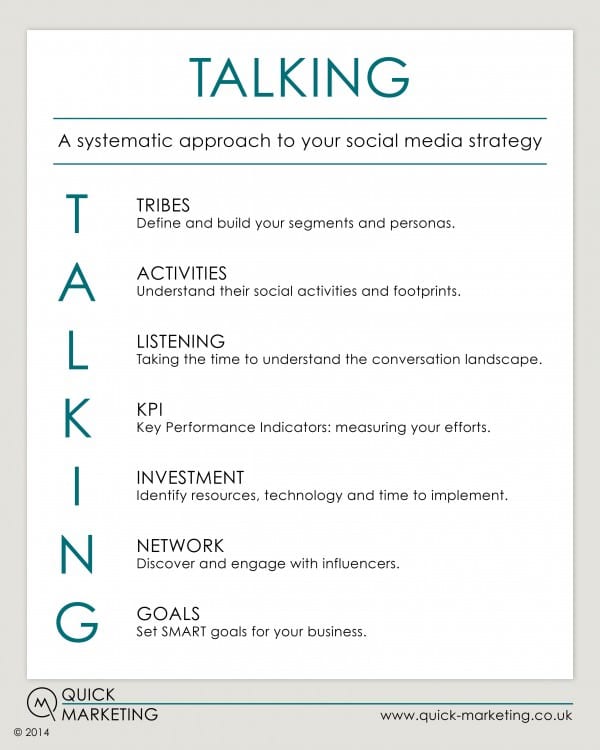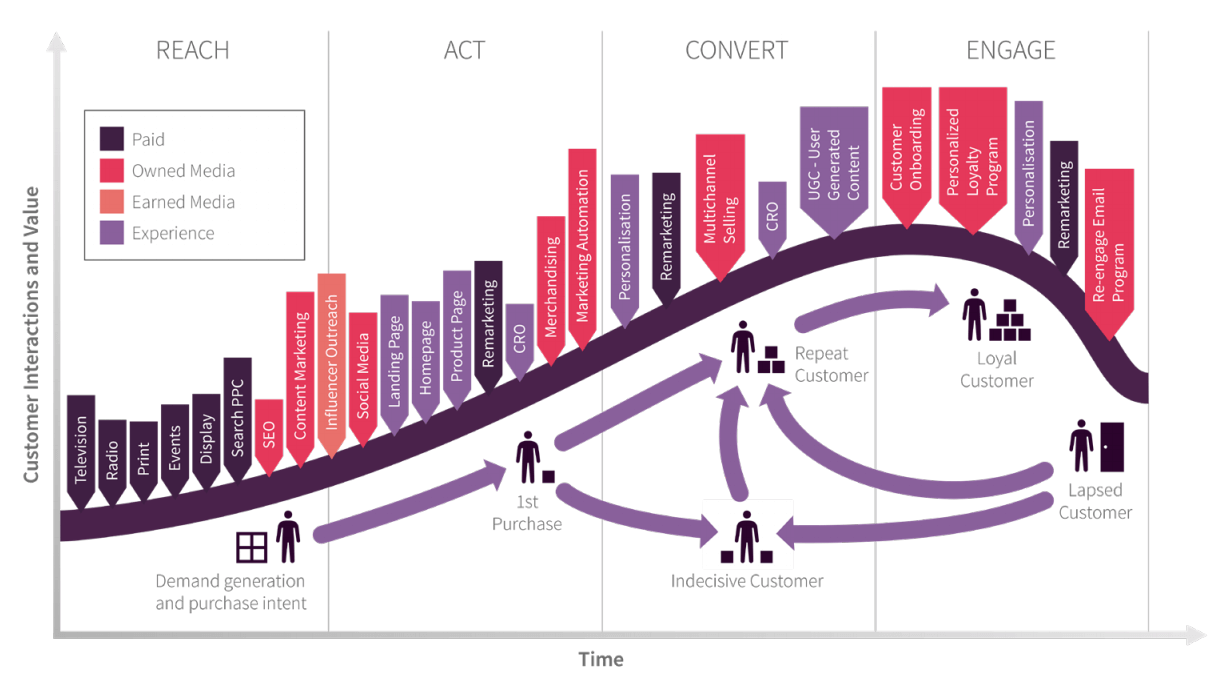Frameworks for managing social media marketing
When I first read Groundswell by Forrester, I really liked their social media management acronym POST. It gave you a simple framework to digest their approach to social, don’t just jump to the technology, look at your People, Objectives, then develop your Strategy and finally implement the Technology.
This inspired me to create my own acronym TALKING, a social media management framework to help shape and champion social media plans. I've used it with many different types of business since and it seems to give rise to good discussions around the main social media strategy and management issues.

7 elements of the TALKING framework to manage your social media marketing
Define and build your segments and personas.
Linking to Seth Godins reference to people being part of tribes of like-minded people who are connected and share goals and interested - in this context I am talking about your segments and persons. It is the first step before you dive right into your strategy is to create your persona for your ideal customers. Find the hooks, the pain points, the problems that they will have and think about how your product or service is going to solve that problem for them.
Understand their social activities and footprints.
Once you have identified your personas you will have a better understanding of what they are doing online.
Do your target audience maintain a profile on networking sites like LinkedIn or Facebook (joiners), do they read blogs or watch videos (spectators), or post reviews (critics) are they creating content (creators), do they bother with social media at all?
Taking the time to understand the conversation landscape.
When you know where your tribes hang out, and you have a confident indication about which social media channels they are using, you need to start listening. If you jump right in and start talking at people with no thought to what content will hook or engage them, you are simply shouting at people who will ignore you and won’t be afraid to publicly tell you that you have missed the mark.
This is the time you want to find groups and see what the hot topics they are talking about. Do your homework; find out who are the influencers that you need to engage with. Don’t forget to listen to what your competition is saying on their channels.
- A tip at this stage is to use Google Trends to map out the hooks and pain points you identified in your personas and listening activity and map out a calendar or topics for your social media conversations.
- If you have social monitoring tools (free or paid) set that up now and monitor the conversations based on your target keywords, brand names, and the issues/ paid points your target audience are interested in.
Key Performance Indicators: measuring your efforts.
Social media can have a bad reputation about being fluffy and not a value driver for a business, but it can and should be measured.
You must demonstrate to the board that your efforts will make a difference to the bottom line, and the only way you can do that is to measure with metrics. Not sure what metrics to use? Don't be fooled by vanity metrics, check out 19 social media metrics that really matter, according to Hootsuite.
Identify resources, technology and time to implement.
You have an idea what social media platform your target audience live, what they talk about, who sways influence, how you are going to measure it. Now you need to identify what your company needs to invest it to make it happen. Social media platforms may be 'free' to set up but many companies fail in their social media strategy by underestimating the resource’s needed overall.
Do you have a dedicated person who is going to monitor and reply to your tweets, who is going to write you blog posts? What is the process if someone posts something bad? What would your social media policy be? Do members of the team need additional training and development? Will you outsource some campaigns to agencies?
Discover and engage with influencers
Influencers…..they will be the ones who with one bad status update will convince a percentage of people in your target audience never to use you, and don’t just base it on number of followers, companies have been knocked down a peg or two by people with a few hundred followers.
Discover your influential bloggers, tweeters and LinkedIn commentators. Use comments and conversation to improve your reputation and brand image. Inspire posts, and create an opportunity to deliver your content and amplify this through influencers. If you have listened well, and invested time in this, it will come across as genuine and not shouting on your soap box.
Set SMART goals for your business
Your social media management framework should provide you with information to link back to company goals- are you doing this for awareness, sales, loyalty, retention?
Google Analytics provides a number of reports to help you analyse how much your social media efforts are impacting your goals and bottom line.
Found within the Acquisition/ Social section of the site, there are a good couple of reports to help you report and gain insights on:
- Network referrals: how much traffic was sent to your site
- Data Hub Activity: shows you the posts that took place whilst sharing content, great for understating trends.
- Landing Pages: lets you the top landing pages from your social referrals.
- Trackbacks: get data on what sources are providing you with traffic, great for finding potential influencers for your brand to work with.
- Conversions: critical for your ROI reporting- how many goals were completed or assisted by social activity and can drill down by platform.
- Plugins Users Flow: most websites now have social sharing plugins, this report will help you understand how people are interacting with your content for example some social sharing buttons may be working better than others, or content types e.g blogs may get more shares on Linkedin than Twitter.
I hope you find the TALKING social media management framework useful. For more on social media marketing management see our Social Media Marketing Learning Path for modules ranging from strategic planning to trends and tactics.
Also, don't forget about our RACE Framework for omnichannel strategy and planning.

Core Module

Structure a plan using Smart Insights’ RACE
Part of the Digital marketing strategy and planning Toolkit
Learn how to structure a comprehensive omnichannel marketing plan, using Smart Insights' RACE
Learn More









